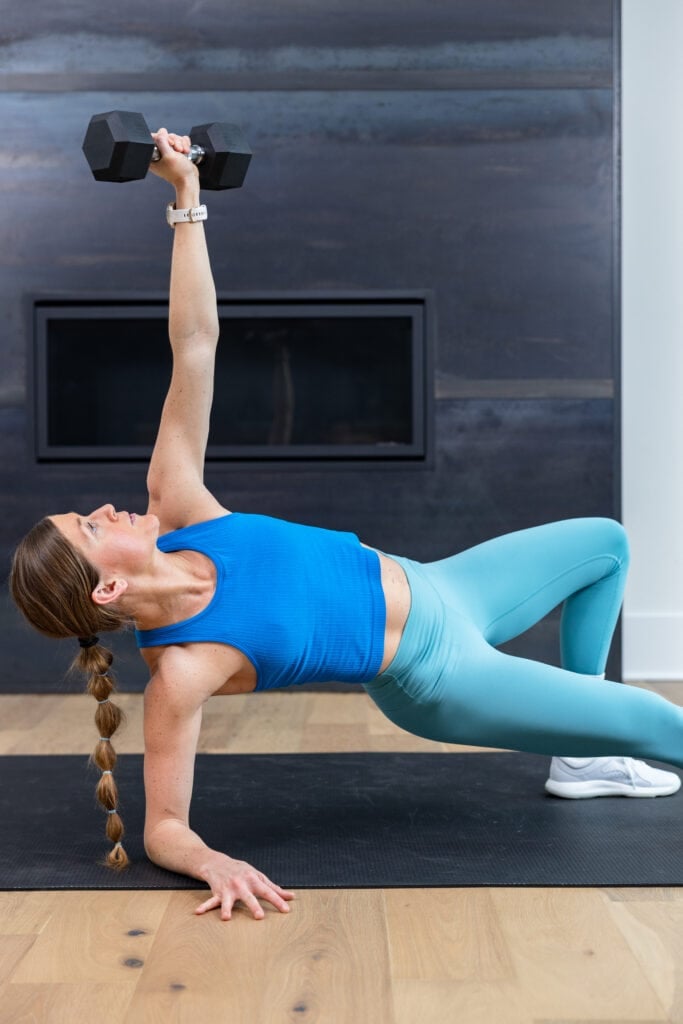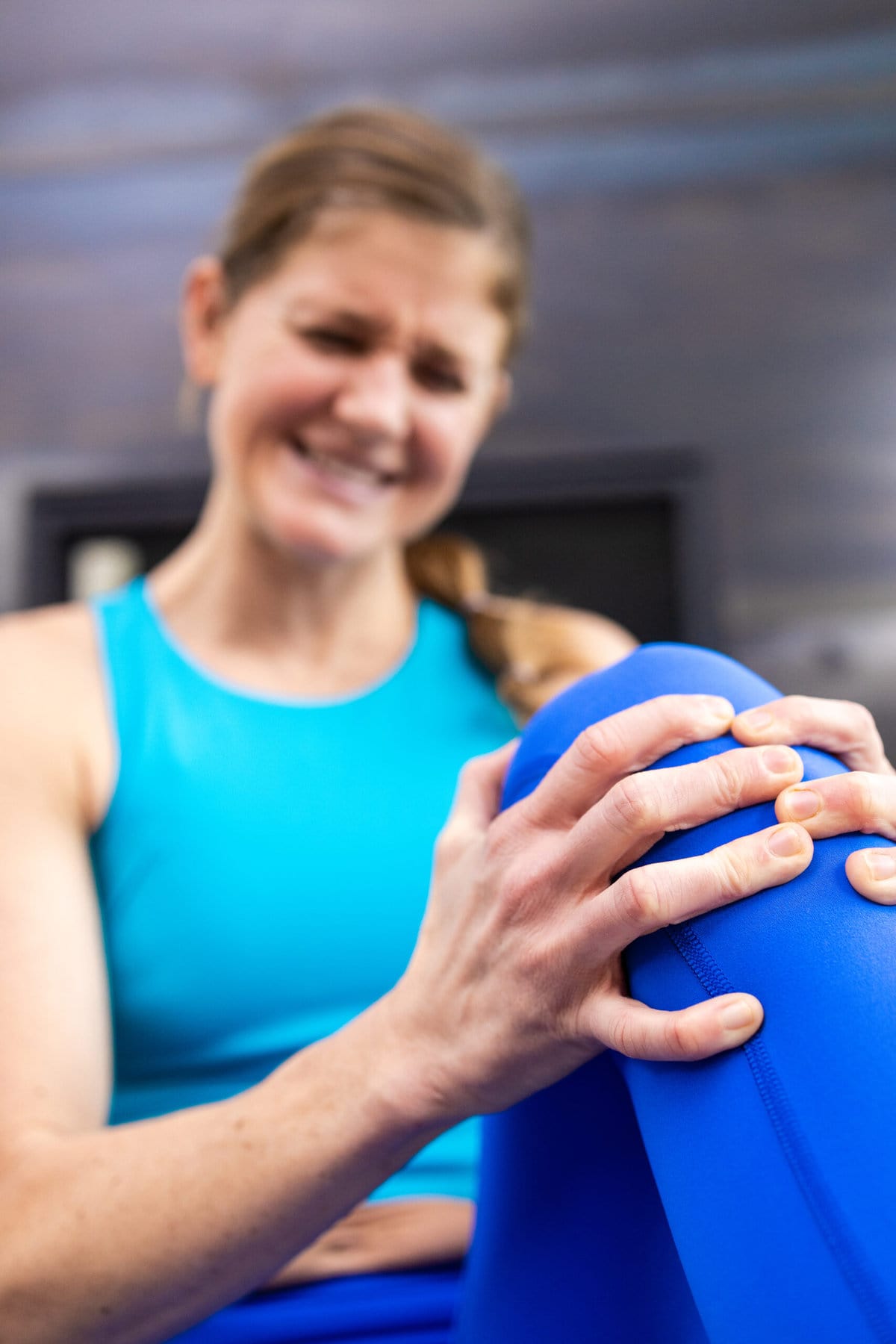Skip the crunches and sit ups – these kettlebell ab exercises are more effective at building strength and definition in your core. I love using kettlebells for ab workouts because their unique design requires our core muscles to stabilize the weight throughout the entire exercise movement. Target the lower abs, upper abs, obliques, transverse abdominis (TVA), lower back and glutes – all from a standing position.
In my opinion, one of the biggest fitness misconceptions is that the best way to get a six-pack is by cranking out thousands of crunches.
The abs, just like any other muscle group, benefit from strength training and progressive overload. That means that in order to build strong, defined abs, you need to be adding load to your ab exercises.
Today’s ab workout uses a single dumbbell or kettlebell to strengthen the abs. I like using a kettlebell in my core workouts for a variety of reasons:
Increased Stabilization: the shape of the kettlebell, with the majority of the weight in the base/bell below the kettlebell horns and handle, means the weight is further from your body. This increases the intensity and improves core engagement and stabilization.
Dynamic, Full-Body Engagement: although this workout is core-focused, kettlebell exercises tend to work multiple muscles at once, making the workout more efficient.
Functional Strength: kettlebell exercises often mimic real-life, daily movements.
We tend to think of classic kettlebell exercises, such as kettlebell swings, as examples of kettlebell leg exercises. However, the explosive hip movement that powers many of the most popular kettlebell exercises requires constant core engagement, making these exercises great for targeting the abs as well.
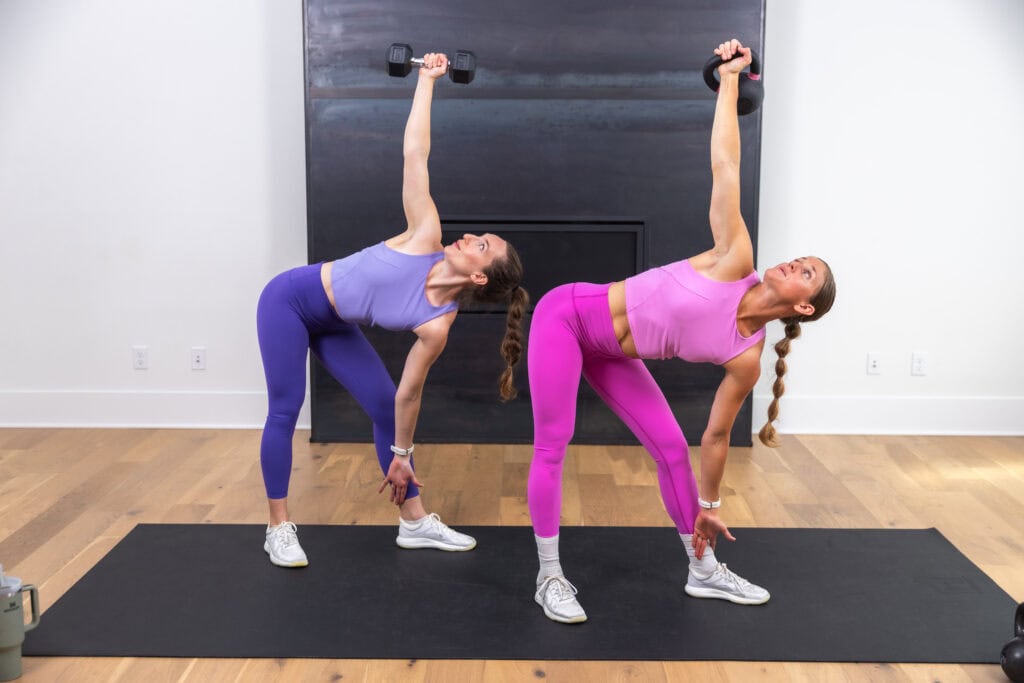
Kettlebell Ab Workout For Strong Abs
Add ab workouts like this to your home workout plan one to two times a week to improve core definition.
If you’re pregnant or postpartum, substitute our popular ab exercises for pregnancy or postpartum diastasis recti exercises.
Workout Instructions:
Follow along with the guided Abs and Core Kettlebell Workout on YouTube, led by certified personal trainer, Lindsey Bomgren.
Your Workout Looks Like This:
7 Kettlebell Ab Exercises (all standing ab workout)
Timed Intervals (40 seconds work, 20 seconds rest)
Repeat All 7 Core Exercises x2 Sets
Workout Equipment:
Medium Kettlebell (discount code: NML5) or Single Heavy Dumbbell. I’m using a 25 lb kettlebell for this workout and Rachel is using a single 15 lb dumbbell.
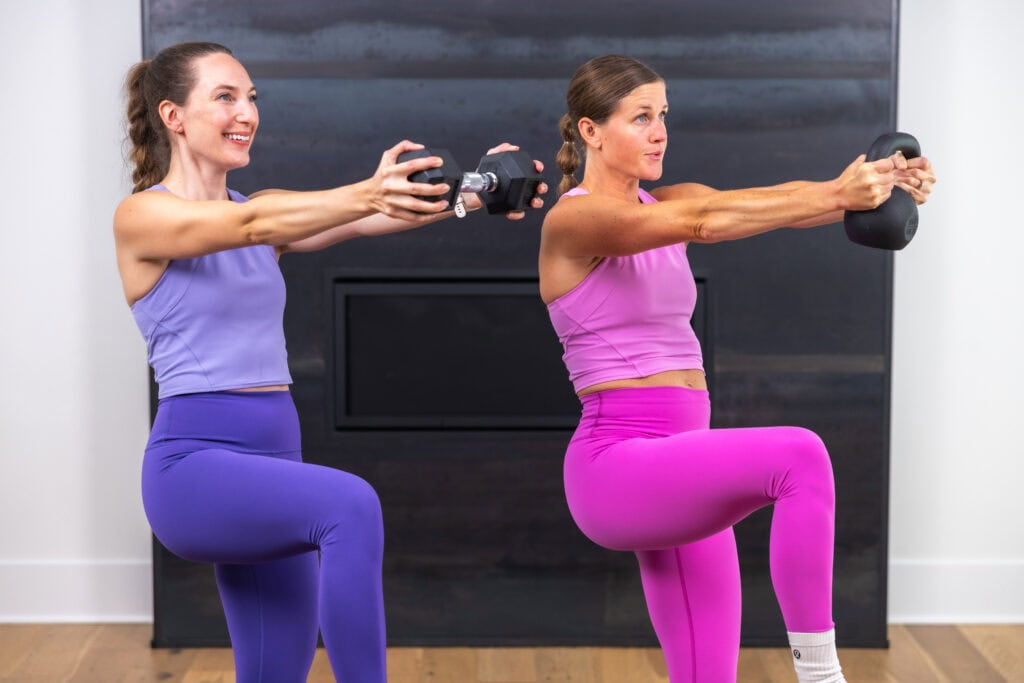
Workout Outline
Squat, Alternating Knee Drive and Kettlebell Press Out
Suitcase Deadlift, Kettlebell Clean and Two Marches
Standing Oblique Crunch
Kettlebell Swing
Single Leg Deadlift and Alternating Row
Around The World, Kettlebell Clean and Uneven March
Windmill
7 Kettlebell Ab Exercises
Squat, Alternating Knee Drive and Kettlebell Press Out
Targets: Legs, glutes, quads, hamstrings, hips, core muscles and shoulders.
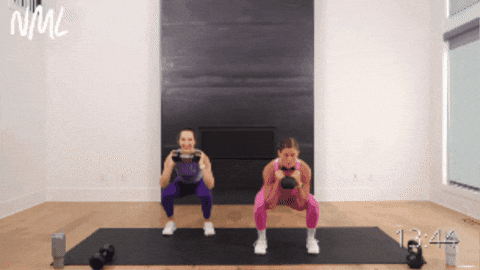
How To Do Kettlebell Squats, Alternating Knee Drives and Press Outs
Stand with feet hip-width apart, knees slightly bent. Hold a kettlebell by the horns at your chest, elbows tucked in narrow.
Sit your hips back as you lower into a squat, striving for a 90-degree angle between your hips and knees.
Then, press through your heels to stand tall, balancing on your left foot and driving your right knee up towards your chest as you stand.
Hold this balance position, then press the kettlebell directly in front of you, extending your arms straight at shoulder level.
With control, return the kettlebell to your chest and place your right foot on the ground, returning to starting position.
Repeat, alternating legs with each knee drive.
Modification: Omit the balance knee drive.
Suitcase Deadlift, Kettlebell Clean and Two Marches
Targets: Glutes, hamstrings, hips, quads, calves, trapezius, deltoids, lower back, abs and core.

How To Do Suitcase Kettlebell Deadlifts, Cleans and Marches
Stand with feet hip-width apart, knees slightly bent. Hold a kettlebell in your left hand at your left side.
Hinge at the hips, pushing your hips back towards the wall behind you as you glide the kettlebell down the outside of your left leg. Think about keeping your core braced to protect your lower back.
Then, drive through your heels to stand tall. As you stand, use the power in your hips and glutes to drive the kettlebell up towards your chest, catching the kettlebell at your left shoulder. This is a kettlebell clean.
Hold the kettlebell at your left shoulder, and then perform two marches: driving first your right knee up towards your chest, then your left knee up towards your chest. Knees are bent to 90 degrees and in line with hips.
Return both feet to the ground, then lower the kettlebell to your left side, returning to the starting position.
Standing Oblique Crunch
Targets: Obliques, upper abs, lower back and core muscles.
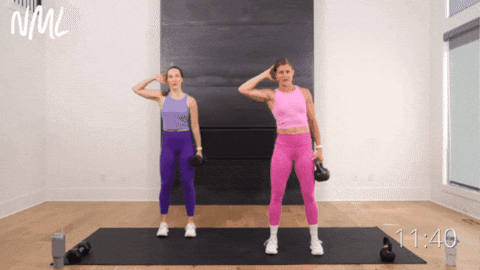
How To Do Standing Oblique Crunches with a Kettlebell
Stand with feet hip-width apart, knees slightly bent. Place your left hand behind your head, left elbow out wide. Hold a kettlebell in your right hand at your right side.
Allow the weight in your right hand to pull you down, sliding the weight down your right thigh and bending through your right side, bringing right ribs to right hip. You should feel a stretch in the opposite (left) obliques.
Then, squeeze through your left outer ab muscles to pull your torso upright, returning to the starting position.
Kettlebell Swing
Targets: The posterior chain (backside of the body) including the glutes, hamstrings, hips, core, and all the stabilizing muscles in your back and shoulders.
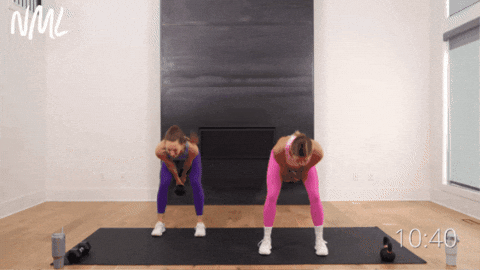
How To Do Kettlebell Swings
Start standing with your feet wider than shoulder-width apart; engage your core.
Hinge forward at the hips to reach for the kettlebell handle with both hands. Place your hands on the horns of the bell, palms facing your body.
Then with a slight bend in your knees and weight in your heels, ‘hike’ the kettlebell back between your legs to start the swing movement.
Drive through your heels to stand tall, pushing your hips forward as you squeeze your glutes to swing the weight up to shoulder height (full hip extension at the top). Aim for shoulder height, with arms extended out away from the body. Think long, loose arms (your arms are just a vehicle for moving the bell, your hips and glutes generate the power to move the bell).
As the kettlebell begins to descend, think of catching the weight with your hip hinge movement, loading the glutes and hamstrings.
Single Leg Deadlift and Alternating Back Row
Targets: The posterior chain or backside of the body — hamstrings, glutes, hips, lower back, mid-back, arms, biceps, abs and core.
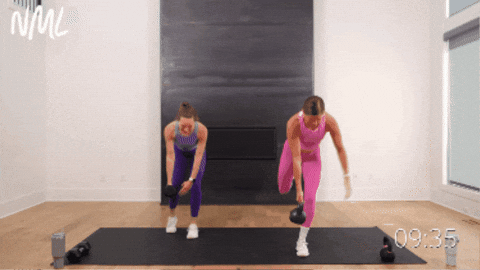
How To Do Single Leg Deadlifts and Alternating Kettlebell Rows
Start standing with feet hip-width apart, knees slightly bent. Hold one kettlebell in your left hand, palm facing your body.
Transfer your weight into your right foot and float your left foot off the floor.
With your right knee bent, hinge at your hips as you lower the kettlebell down towards the ground, balancing on your right leg. Keep your hips square to the mat. You should feel a good stretch in your right hamstring (back of your right leg) at the bottom of this movement. Range of motion looks different for everyone.
Hold this single leg deadlift position, then perform a single arm row by pulling the kettlebell back toward your left hip.
Lower the kettlebell with control, then transfer the kettlebell to your right hand.
Perform a single arm back row on the right by pulling the kettlebell towards your right hip.
Continue this pattern, holding a single leg deadlift position and alternating kettlebell back rows on each side of the body.
Modification: Perform a staggered deadlift rather than a single leg deadlift for more balance support.
Around The World, Kettlebell Clean and Uneven March
Targets: Deep transverse abdominals, obliques, lower abs, upper abs, biceps, hips and glutes.
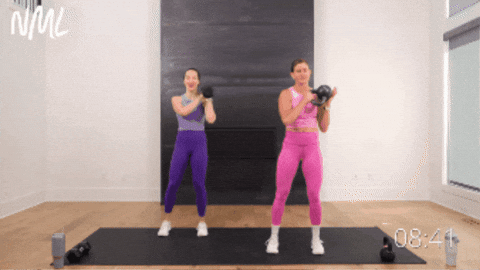
How To Do Kettlebell Around The Worlds, Cleans and Uneven Marches
Start standing with feet hip-width distance apart, shoulders stacked over hips and pelvis slightly tucked to engage the core.
Hold a kettlebell by the handle in your right hand outside of your right hip. Keep core muscles tight, aiming to keep your upper body as still as possible.
Then, pass the kettlebell behind your body, transferring it to your left hand behind your back.
Now holding the kettlebell in your left hand, “clean” across your body, bringing your right hand up to help catch it at your right shoulder.
Hold this clean position as you drive your left knee up so that left thigh is parallel to the ground, performing an uneven march.
Then, reverse the movement, keeping the kettlebell in your left hand as you return your left leg to the ground and bring the kettlebell towards your left hip.
Pass the kettlebell behind your back, transferring from left hand to right hand midway behind your back.
Then, “clean” the kettlebell up across your body, bringing your left hand up to help catch it at your left shoulder.
Hold this clean position as you drive your right knee up, performing an uneven march on the right side of the body.
Modification: Option to omit the “around the world” transfer, performing instead alternating cleans and uneven marches.
Kettlebell Windmill
Targets: Obliques, abs, upper back, outer glutes, inner thighs, hamstrings, upper body and shoulder stabilizers.
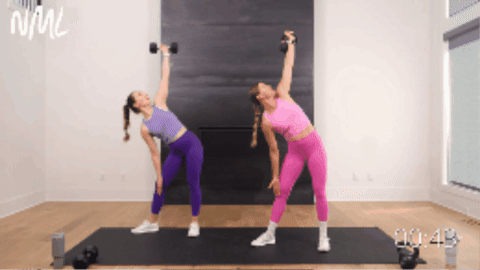
How To Do Kettlebell Windmills
Start in a wide stance, holding a kettlebell in your left hand, directly above your shoulder.
Rotate your right foot out 90 degrees so your right toes are pointing towards the top of your mat, then pivot your left foot slightly inwards (about a 45 degree angle). The heel of your right foot is aligned with the arch of your left foot.
Focus on creating and maintaining length through your waist as you hinge at the hips, sliding your right arm down your right leg. Keep your left arm directly above your left shoulder, maintaining a straight line with the kettlebell. Range of motion will look different for everyone
Then, squeeze through your obliques to pull your torso back upright, returning to starting position.
FAQs
A good kettlebell weight is one that allows you to complete 10-15 repetitions of an exercise with good form. You want a weight that is heavy enough to lead to muscle growth, but not too heavy (which can compromise form, leading to injury). I recommend starting with a kettlebell between 15-25 lb depending on your fitness level.
One of the most common errors I see with kettlebell swings is “snapping” the hips too far forward, leading to an overextension of the lower back. Instead of “snapping” the hips, think about driving through your heels to stand tall.
Kettlebells are extremely effective at building core strength, as they force the core to brace and stabilize during big, dynamic movements. Training your core with kettlebells also encourages more strength and stability through the spine during compound lifts, such as squats, deadlifts and cleans.
Forget Sit Ups, Pin These 7 Kettlebell Ab Exercises
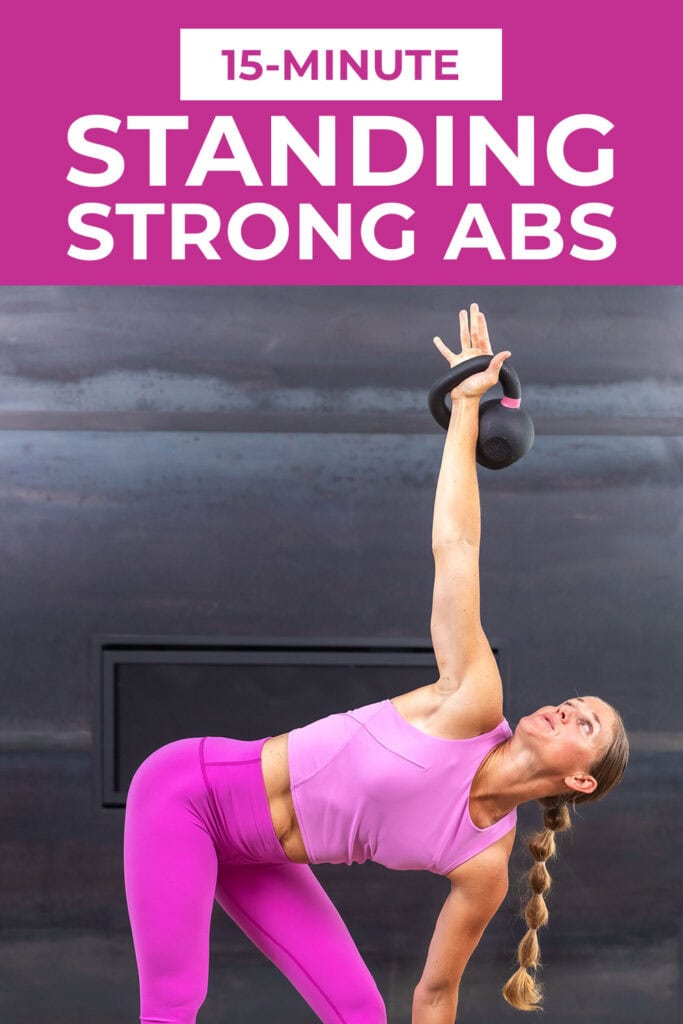
This post includes affiliate links. I do earn a commission for products purchased using these links (at no additional cost to you). Thank you for supporting Nourish Move Love, making the content you see on this blog possible.

